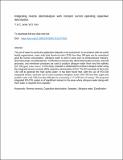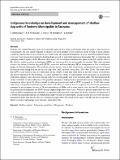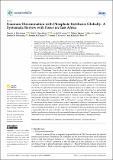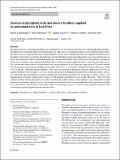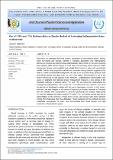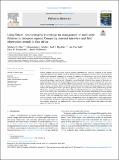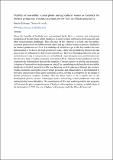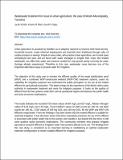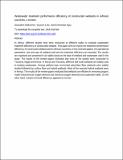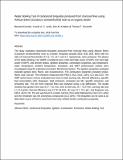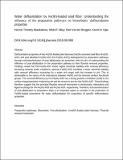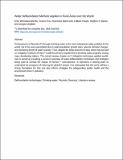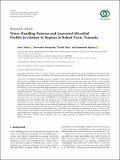Browsing Research Articles [MEWES] by Title
Now showing items 418-437 of 447
-
Ultrapure water from seawater using integrated reverse osmosis-capacitive deionization system
(Taylor & Francis Online, 2013-12-19)The use of water for particular application depends on its purity level. In accordance with the world health organization, water with total dissolved salts (TDS) less than 500 ppm can be considered good for human consumption. ... -
Understanding the Emergence and Functioning of River Committees in a Catchment of the Pangani Basin, Tanzania
(Water Alternatives, 2011-06)In this paper we explore the emergence and functioning of river committees (RCs) in Tanzania, which are local water management structures that allocate and solve water conflict between different water users (smallholder ... -
Uranium Dissemination with Phosphate Fertilizers Globally: A Systematic Review with Focus on East Africa
(MDPI, 2024-01-09)Growing concern has been expressed about uranium (U) accumulation in agricultural soils caused by the long-term application of mineral fertilizers. More than 80% of naturally occurring U transfers from phosphate rock ... -
Uranium in phosphate rocks and mineral fertilizers applied to agricultural soils in East Africa
(Springer Link, 2022-12-11)Phosphate rock, pre-concentrated phosphate ore, is the primary raw material for the production of mineral phosphate fertilizer. Phosphate rock is among the fifth most mined materials on earth, and it is also mined and ... -
Use of 210Pb and 137Cs radionuclides as simple method of estimating sedimentation rates on reservoir
(Egyptian Society of Nuclear Sciences and Applications (ESNSA), 2023-01)Reservoirs are important for flood control, production of hydroelectric power, fishing, water harvesting and storage. Climate is changing, population and anthropogenic activities are increasing which increase sedimentation ... -
Using fishers’ local ecological knowledge for management of small-scale fisheries in data-poor regions: Comparing seasonal interview and field observation records in East Africa
(Elsevier, 2023-08)Fishers, scientists and policy makers need to describe, understand and “agree on” variations in fish catches caused by exploitation and climate change for effective fisheries management. To achieve this, relevant data with ... -
Viability of non-edible oilseed plants and agricultural wastes as feedstock for biofuels production: A techno-economic review from an African perspective
(Biofpr, 2023)Given the benefits of biofuels over conventional fuels, there is concern that widespread production of biofuels from edible feedstocks to meet demand will lead to food insecurity and other socioeconomic challenges. Thus, ... -
Vibrational and Electronic Spectra of Natural Dyes Constituents for Solar Cell Application: DFT and TDDFT Study
(Science Publishing Group, 2015-09-09)Selected constituents of natural dyes, phenol, 1,2-benzoquinone, 1,4-benzoquinone, 1,4-naphthoquinone, and 9,10-anthraquinone have been studied theoretically using the density functional theory and time-dependent density ... -
Wastewater Treatment and other Research Initiatives with Vetiver Grass
(University of Dar es Salaam, 2003)This paper described the role of substrate (soil) with respect to the type of macrophytes (plants) planted in the wastewater treatment in Horizontal Subsurface Flow (HSSF) Constructed wetlands (CWs). Wastewater parameters ... -
Wastewater treatment for reuse in urban agriculture; the case of Moshi Municipality, Tanzania
(Pergamon, 2014-01-01)Urban agriculture is practiced by dwellers as an adaptive response to improve their food security, household income, create informal employment and diversify their livelihood through sales of surplus produce or savings. ... -
Wastewater treatment performance efficiency of constructed wetlands in African countries: a review
(IWA Publishing, 2015-01-01)In Africa, different studies have been conducted at different scales to evaluate wastewater treatment efficiency of constructed wetland. This paper aims to review the treatment performance efficiency of constructed wetland ... -
Water allocation and management in an emerging spate irrigation system in Makanya catchment, Tanzania
(Elsevier, 2011-09)Although spate irrigation systems are risk-prone, they can be an important component for livelihood security in semi-arid areas. Spate uses water (flood water), which upstream users often do not require, as rainfall during ... -
Water Boiling Test of carbonized briquettes produced from charcoal fines using African Elemi (Canarium schweinfurthii) resin as an organic binder
(Springer Nature Switzerland AG., 2021-10-10)The study evaluated carbonized briquettes produced from charcoal fines using African Elemi (Canarium schweinfurthii) resin as a binder. Briquette samples (B25, B30, B35, B40) with the ratio of charcoal fines:binder of 3:1, ... -
Water defluoridation by Fe (III)-loaded sisal fibre: Understanding the influence of the preparation pathways on biosorbents’ defluoridation properties
(Elsevier, 2019-01-15)Defluoridation properties of two Fe(III)-loaded plant biomass (Fe(III)-activated sisal fibre (Fe(III)-ASF) and post-alkalized Fe(III)-ASF (PA-Fe(III)-ASF)) distinguished by preparation pathways through exclusion/inclusion ... -
Water defluoridation by Fe(III)-loaded sisal fibre: Understanding the influence of the preparation pathways on biosorbents’ defluoridation properties
(Elsevier, 2019-01-19)Defluoridation properties of two Fe(III)-loaded plant biomass (Fe(III)-activated sisal fibre (Fe(III)-ASF) and post-alkalized Fe(III)-ASF (PA-Fe(III)-ASF)) distinguished by preparation pathways through exclusion/inclusion ... -
Water Defluoridation Methods Applied in Rural Areas over the World
(IntechOpen Limited, 2022-06-23)Overexposure to fluoride (F) through drinking water is the most widespread water problem in the world, but it has now exacerbated due to rapid population growth rates, adverse climatic changes, and increasing levels of ... -
Water defluoridation using Al/Fe/Ti ternary metal oxide-loaded activated carbon by capacitive deionization
(Royal Society of Chemistry, 2023-01-26)Capacitive deionization (CDI) is an environmentally friendly water treatment technology with low energy consumption. For a long time, activated carbon has been a preferred electrode material for CDI owing to its availability, ... -
Water hardness removal by coconut shell activated carbon
(Science Publishing Group, 2014-08-30)The present study reports the water softening by adsorption of hardness ions onto Coconut Shell Activated Carbons (CSAC). Characterization of CSAC was identified by FT-IR and SEM techniques. Batch experiments were ... -
Water quality in earthen dams and potential health impacts: case of Nadosoito Dam, Tanzania
(IWA Publishing, 2018-09-01)The aim of the study was to assess seasonal water quality variations in an earthen dam and their potential impact on the health of those using the water for domestic purposes. High values of chemical oxygen demand, from ... -
Water-Handling Patterns and Associated Microbial Profiles in relation to Hygiene in Babati Town, Tanzania
(Hindawi Journal of Environmental and Public Health, 2019-05-20)In rapidly urbanizing centres in Tanzania, water supply infrastructure lags behind the speed of urbanization, affecting water availability and accessibility. We believe that inhabitants’ access water using various ways ...

